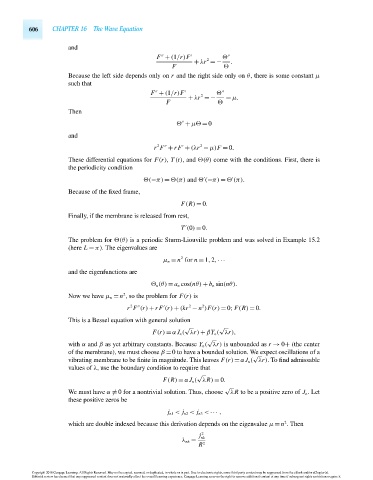Page 626 - Advanced_Engineering_Mathematics o'neil
P. 626
606 CHAPTER 16 The Wave Equation
and
F + (1/r)F 2
+ λr =− .
F
Because the left side depends only on r and the right side only on θ, there is some constant μ
such that
F + (1/r)F
2
+ λr =− = μ.
F
Then
+ μ = 0
and
2
2
r F +rF + (λr − μ)F = 0.
These differential equations for F(r), T (t), and (θ) come with the conditions. First, there is
the periodicity condition
(−π) = (π) and (−π) = (π).
Because of the fixed frame,
F(R) = 0.
Finally, if the membrane is released from rest,
T (0) = 0.
The problem for (θ) is a periodic Sturm-Liouville problem and was solved in Example 15.2
(here L = π). The eigenvalues are
2
μ n = n for n = 1,2,···
and the eigenfunctions are
n (θ) = a n cos(nθ) + b n sin(nθ).
2
Now we have μ n = n , so the problem for F(r) is
2
2
2
r F (r) +rF (r) + (kr − n )F(r) = 0; F(R) = 0.
This is a Bessel equation with general solution
√ √
F(r) = αJ n ( λr) + βY n ( λr),
√
with α and β as yet arbitrary constants. Because Y n ( λr) is unbounded as r → 0+ (the center
of the membrane), we must choose β = 0 to have a bounded solution. We expect oscillations of a
√
vibrating membrane to be finite in magnitude. This leaves F(r) = αJ n ( λr). To find admissable
values of λ, use the boundary condition to require that
√
F(R) = αJ n ( λR) = 0.
√
We must have α = 0 for a nontrivial solution. Thus, choose λR to be a positive zero of J n .Let
these positive zeros be
j n1 < j n2 < j n3 < ··· ,
2
which are double indexed because this derivation depends on the eigenvalue μ = n . Then
j 2
λ nk = nk
R 2
Copyright 2010 Cengage Learning. All Rights Reserved. May not be copied, scanned, or duplicated, in whole or in part. Due to electronic rights, some third party content may be suppressed from the eBook and/or eChapter(s).
Editorial review has deemed that any suppressed content does not materially affect the overall learning experience. Cengage Learning reserves the right to remove additional content at any time if subsequent rights restrictions require it.
October 14, 2010 15:23 THM/NEIL Page-606 27410_16_ch16_p563-610

